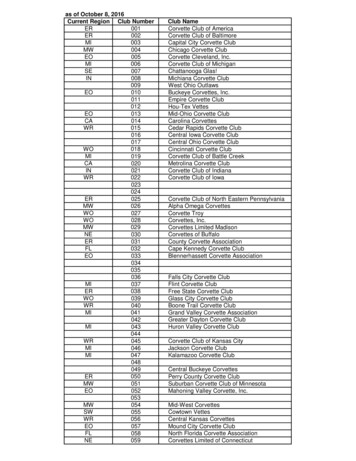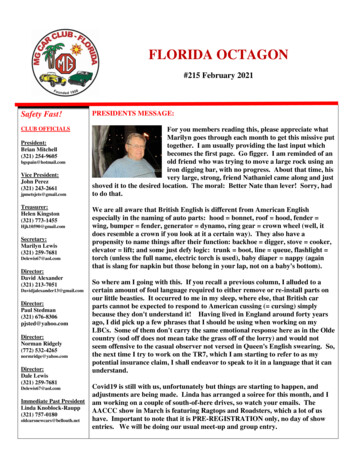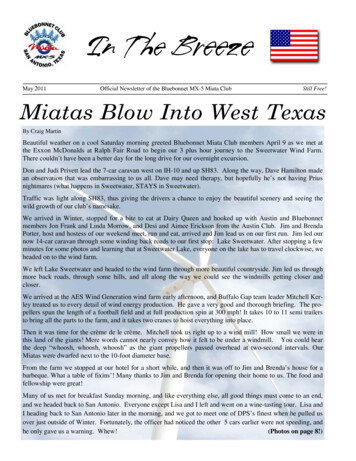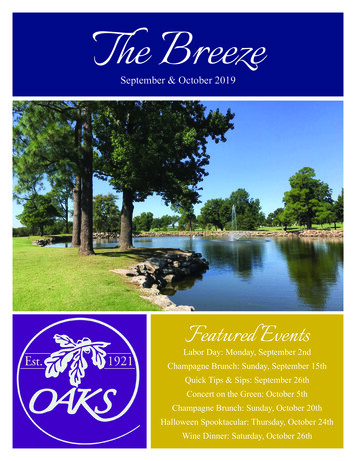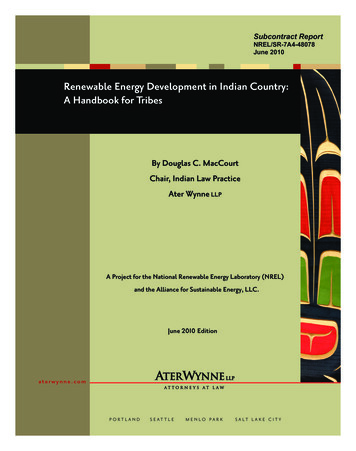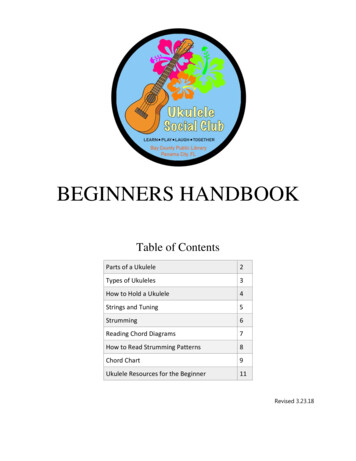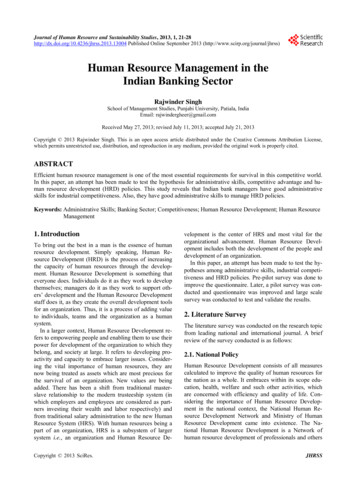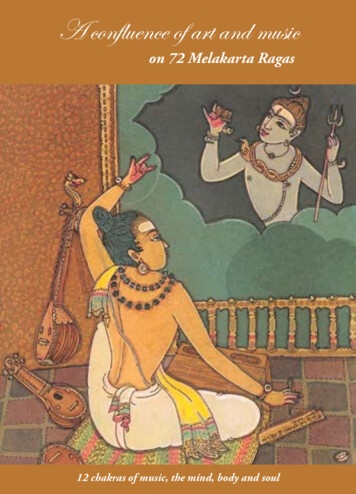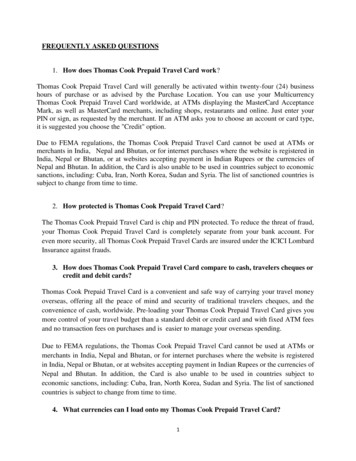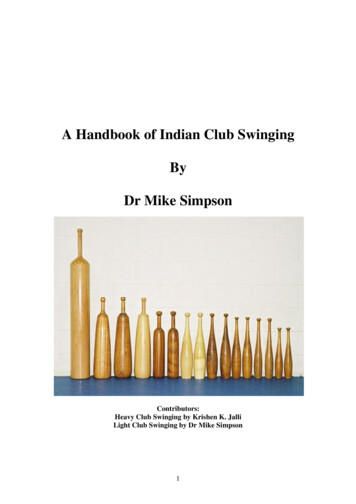
Transcription
A Handbook of Indian Club SwingingByDr Mike SimpsonContributors:Heavy Club Swinging by Krishen K. JalliLight Club Swinging by Dr Mike Simpson1
A Handbook of Indian Club SwingingByDr Mike SimpsonStrategy Games Limited, Sheffield, UK2
DisclaimerThe exercises shown in this handbook and accompanying DVD were performed byexperts. These exercises can cause injury if not performed correctly. Do not attemptthese exercises unless you have had instruction from a recognised expert, personaltrainer or professional coach. We take no responsibility for any injury to you or anythird party as a result of attempting to perform these exercises. You are stronglyadvised to seek the opinion of your medical practitioner before attempting any of theexercises shown in this handbook and accompanying DVD. Your safety and thesafety of others working out in your vicinity is your responsibility and you have aduty of care when attempting to perform any exercise or exercise routine shown inthis handbook and accompanying DVD.3
Strategy Games Limited13 Goodison Rise,SheffieldS6 5HWUKwww.indianclubswinging.co.ukFirst Published 2009 M. Simpson, 2009The rights of Michael Simpson to be identified as author of this work have beenasserted in accordance with the Copyright, Designs and Patents Act 1988.All rights Reserved. No part of this publication may be reproduced, stored in aretrieval system, or transmitted in any form or by any means, electronic, mechanical,photocopying, recording or otherwise, without either prior permission of the publisheror a licence permitting restricted copying in the United Kingdom issued by theCopyright Licensing Agency Ltd, 90 Tottenham Court Road, London W1T 4LP.ISBN 978-09562567-0-64
ContentsPageDisclaimer3Preface61.Introduction to Indian Club Swinging8 About this Handbook9 About the accompanying DVD10 Shapes, Weights and Sizes of Indian Clubs11 Materials Treatments and Storage of Indian Clubs142.Getting Started, Warming up and Warming Down163.Basic Exercises with Indian Clubs19 Direction of the swings19 Basic Stances for Indian Club Swinging19 Pendulums21 Pendulums with Hand Changes22 Double Handed Pendulums25 Circles28 Single Handed Circles28 Double Handed Circles28 ‘Helicopter’ Circles above the Head294.5.Intermediate Exercises with Indian Clubs30 Swings (Heart Shaped)30 Single Handed (Heart Shaped) Swings30 Double Handed (Heart Shaped) Swings31Advanced Exercises with Indian Clubs38 Wrist Twists38 Shoulder Rotations41 Hand Changes42 Throwing, Flipping and Tossing the Clubs45 A Final Comment on Snakes466.Combinations477.Heavy Indian Club Swinging Exercises49References53Appendix 1. Obtaining Indian Clubs from the Author555
PrefaceI first encountered Indian club swinging over 20 years ago (circa 1985) at a local Judoclub where one of the club members, Dr Colin Hughes, gave a short demonstration foranyone interested in watching. I was interested and impressed simply because of theunusual form of exercise being shown with what appeared to be quite large and fairlyheavy clubs. In those days I was heavily involved in martial arts and practising Judo,Ju Jitsu, Aikido and Kyushindo (a mix of Judo, Jiu Jitsu, Aikido, self-defence andKendo) and just starting my interest in Iaido (Japanese Swordsmanship). These artsrequired high levels of fitness and I was busy running and weight training atlunchtime on my own account.A few years later I moved to a research position at the University of Sheffield whereagain I encountered Indian club swinging being run by Dr Colin Hughes at lunchtimeon Monday, Tuesday and Thursday at the University Sports Centre onNorthumberland Road in Sheffield. Colin was using Indian club swinging as the basisof a fairly comprehensive fitness regime in which skipping, running, stretching and allforms of exercise were being used. This was a really great class for getting fit andcross training for my martial arts classes. It appears that Indian club swinging hadbeen introduced to the lunchtime classes by someone working at the sports centre thathad been in the armed forces and had learnt the art there. Colin and the lunchtimeClub Swingers had picked up these skills and read further on the subject to developtheir skills and continued the practice. Later Colin moved to the University ofManchester and I lost touch with him.Since those days I have concentrated my efforts on a few martial arts and given upJudo and Ju Jitsu due to injuries and lack of time. However, I have not given up myIndian club swinging and still find it fascinating, great for keeping fit and strangelyrelaxing and invigorating.I must say I am indebted to Dr Colin Hughes for leading such an excellent fitnessclass. I am also indebted to Professor John Norman and Professor Rachel Davey (nowat Staffordshire University) for showing me how to do the swings in my early days ofpractice and I am indebted to the lunchtime Indian club swingers at the University ofSheffield for their kindness and camaraderie over the years. I am particularly indebtedto Mr Krishen Jalli for the insight into really heavy Indian club swinging. We haveincluded a section on heavy club swinging on the accompanying DVD and I hope thatit will be an inspiration to all those people swinging lighter clubs to progress furtherin their endeavours. There are a number of embarrassing outtakes on the DVD toowhich show just how difficult heavy club swinging really is – even for experts.I hope this handbook and associated DVD will pass on my knowledge andunderstanding of this art form.Dr Mike Simpson, February 2009.6
University of Sheffield Indian Club Swinging Group (Circa 1990) Outside theGoodwin Sports Centre, Bramley Field, Northumberland Road, Sheffield, UK.Back Row (Standing) from left:Graham Hough, PhD Student, PhD Student, Pauline (?), Pat Seyd, Dennis Regan,Peter Hannon, Ros Seyd, Colin White, John Norman, PhD Student, Rachel Davey.Front row (kneeling and seated) from left:Mary (PhD student), ?, John Gilbert, Derrick White, Mike Simpson, Colin Hughes.7
Chapter 1. Introduction to Indian Club SwingingIndian club swinging has been around for thousands of years according to someauthorities and was originally used as a method of close combat attack and defenceand it is claimed that clubs were also used in warfare. There is evidence that clubswinging started in India about 7000 years ago because religious books such asMahabharata, Ramayana and Gita mention clubs. It is said that Lord Vishnu andHanuman always kept their Mace (a type of club) in their hands. However, clubs wereinvented by human beings to use as a weapon at the time of war and to keep fit andstrong in times of peace.The use of clubs certainly originated in central Asia but quickly spread to the east andwest and various countries such as Persia, Turkey, Indonesia and the Philippines havesome form of club swinging or stick system which has been preserved to the presentday by wrestlers, martial artists and through family tradition. Indian club swingingwas practiced as a martial art form where various weights of clubs were swung inmany different ways around the body to improve fitness, strength, stamina andsuppleness of the wrists. All of these exercise routines were aimed at improving thefighting skills of the warrior.The British in India noticed that the local men, especially the wrestlers, wereparticularly strong and well built individuals and also noticed that the use of clubs wasfairly common. Thus, Indian club swinging was introduced into the British armedforces as part of the physical training regime undertaken by the troops. This hassurvived to the modern day in the British armed forces physical training of newrecruits. However, the civilian population also embraced the value of Indian clubswinging for fitness and health. The American school physical education curriculumincluded Indian club swinging until about the 1960s. In the UK Indian club swingingwas used by schools, women’s fitness groups, and gentlemen’s clubs (these were themodern day equivalent of a private gymnasium) up until about the same time. In theearly part of the 20th century and late 19th century club swinging was very popularindeed. There were Indian club swinging competitions, endurance records were setand professional strong men and wrestlers were using Indian clubs to train with and todemonstrate their strength and skills. Several notable strong men wrote Indian clubswinging manuals and regularly tried to break each others endurance records. Clubswere manufactured in large numbers commercially and in a variety of shapes andsizes. Some of these clubs can still be found in antique shops and attics.The popularity of Indian club swinging appeared to decline after the 1960s. While afew older folk remember the art form many of the skills have been lost or preserved inmanuals and books which are perhaps less than helpful in trying to (re)learn the artform. These books are now rare, hard to obtain and look almost alien in nature. If youcannot obtain the clubs either, then these manuals and the techniques they describelook odd and strangely out of place in our modern society. A recent experience ofmine was at my local gym when I was doing some sit-ups with a club and was askedby a young woman what the clubs were. Before I could reply an old chap (70 yearsplus) picked up the clubs and did some very expert swings with them to theamazement of the younger people at the gym! He had not swung clubs for over 30years!At the present time (2009) Indian club swinging seems to be making a return. Manyphysical fitness enthusiasts, personal trainers, weight lifters and of course wrestlershave looked at the deficiencies of modern training methods and sought out the8
traditional methods of fitness training such as Indian clubs, medicine balls, skippingropes (jump rope), kettle bells, juggling, hula hoops, other circus skills and so on.These ‘old fashioned’ methods may not be scientifically proven to be better thanmodern training methods for athletes but they are more interesting, place unusualdemands on the human body and human mind and add variety that modern trainingmethods often lack. In addition, the individual can see progress in developing a skillas well as fitness or strength or both and this is especially important for those peoplenot involved in or obsessed by competitive sports. Indian club swinging offers a wayforward to develop the skills, the strength, the fitness and stamina of the athlete whilealso ensuring mobility and flexibility in the arms and shoulders. (Note: I have usedthe word ‘athlete’ to cover anyone, at any age, training and developing their skills andimproving their fitness. I have used this word throughout this handbook as it properlydescribes someone trained or training in exercises to develop skills in my opinion).About this HandbookThis basic manual is about Indian club swinging as I understand it. There appear to betwo types of club swinging that can be found today. These types of club swingingdepend on the weight of the clubs being handled and swung. The lighter weight clubsup to 5Kg (11 lbs) seem to result in a more open style of swinging clubs with big freemovements around the shoulders and joints of the arm and including some elementsof juggling such as throwing, flipping and tossing the clubs. The clubs are oftenswung at arms length and with greatly extended swings. This is the style I understandwell and have spent more than 20 years practicing. This style has its origins in theBritish armed forces and is generally a good all round strength and fitness trainingstyle. I do not know if this style of club swinging has a particular name but I havecalled it the ‘Open Style’ to make it clear that the shoulder joints are used to thefullest extent. This style is ideal for physiotherapeutic treatments with light weightclubs.Using much heavier clubs up to 20Kg (44 lbs) or more requires a different method ofhandling the clubs. The sheer weight of these clubs is such that they cannot be easilyheld and swung at arms length and instead the clubs are rotated in various waysaround the shoulders and around the head with the arms held bent. Technically, theseexercises are extremely difficult to do, require exceptional skill and co-ordination athandling heavy weights and require enormous shoulder strength – possibly beyondthat which might be acquired from weight training alone – and take many years tolearn and perfect. This style I have called the ‘Closed style’ as the shoulders are notmoved through the full range of movement and appear quite closed in. This isapparent from the DVD footage we have of Mr Krishen Jalli.It should be noted that there is a relationship between the weight of clubs used and thetechniques that can be performed by the average person. Juggling with very lightweight clubs (250g or ½ lb) is one extreme of club swinging. With heavier weights upto 5Kg (11 lbs) this allows for some juggling techniques but the ‘Open Style’ ofswinging clubs is a more natural and obvious way of handling the clubs to themaximum benefit of the athlete. Beyond about 5Kg (11 lbs) depending on your size orbuild juggling becomes almost impossible to do, some of the techniques carried out atarms length become more difficult to do well and man handling the weight becomesmore problematic. At weights beyond 10Kg (22 lbs) I would say that the ‘ClosedStyle’ of club swinging is more natural and the techniques are specifically designedwith the shoulders and back in mind as the main area of the body being exercised.9
However, the sheer weight of the clubs (especially at 20Kg; 44 lbs) places enormousstresses on all parts of the body and the back, arms, legs and stomach muscles aregiven a good workout.The weight lifters reading this will be puzzled I am sure but it is not the absoluteweight that is at issue here. In normal weight training one might expect to exercisewith these sorts of weights very easily and on many exercises exceed these weights
The exercises shown in this handbook and accompanying DVD were performed by experts. These exercises can cause injury if not performed correctly. Do not attempt these exercises unless you have had instruction from a recognised expert, personal trainer or professional coach. We take no responsibility for any injury to you or any third party as a result of attempting to perform these exercises .

